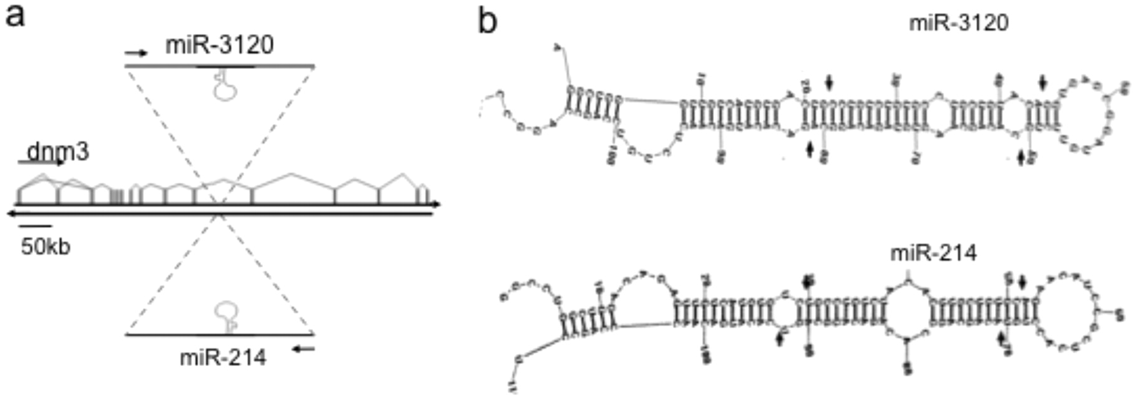How mirror genes in ‘Junk DNA’ control brain processes, doubling the double helix
April 30, 2012

Mirror-microRNAs: (a) location in DNA; (b) miR-3120 and miR-214, on opposite strands (credit: H. Scott et al./Journal of Biological Chemistry)
University of Bristol researchers have discovered a new group of molecules called called mirror-microRNAs that control some of the fundamental processes behind memory function and may hold the key to developing new therapies for treating neurodegenerative diseases.
MicroRNAs are non-coding genes that often reside within “junk DNA” and regulate the levels and functions of multiple target proteins that are responsible for controlling cellular processes in the brain. Two microRNA genes with different functions can be produced from the same piece (sequence) of DNA, the research found — one from the top strand and another from the bottom complementary “mirror” strand.
Controlling memory and communication in the brain
One microRNA is expressed in the parts of nerve cells that are known to control memory function and the other microRNA controls the processes that move protein cargos around nerve cells. miRNAs can coordinate the expression of genes in response to neuronal activity and are being shown to be important regulators of synaptic function.
“Very small changes in miRNA genes will have a dramatic effect on brain function and may influence our memory function or likelihood of developing neurodegenerative diseases,” said James Uney, Professor of Molecular Neuroscience in the University’s School of Clinical Sciences. “These findings also suggest that many more human mirror microRNAs will be found and that they could ultimately be used as treatments for human neurodegenerative diseases such as dementia.”
MicroRNAs work by binding to messenger RNA (mRNA) to adjust protein levels. MicroRNAs have already been found throughout the double helix, lying in between genes or in areas of the code for a single gene that would normally be discarded. These areas, once considered “junk DNA,” are now revealing a more complex and important role.
Both sides of the double helix can each produce a microRNA that are almost a perfect mirror of each other, but due to slight differences in their sequence, they regulate different sets of protein-producing RNAs, which will in turn affect different biological functions. The mirror-microRNAs are likely to represent a new group of microRNAs with complex roles in coordinating gene expression, doubling the capacity of regulation, according to the researchers.
How DNA and RNAs work
The double stranded DNA helix discovered by Watson and Crick holds all the information needed for life. Each strand of DNA is made up of a chain of units called bases. There are four different bases and it is the sequence of these bases that holds the information in sections called genes.
For the information to be used, the sequence of DNA bases must be copied onto another molecule called RNA. Some RNAs are used to produce proteins, while other regulatory RNAs (called microRNAs) can control the production of multiple proteins. Together, these RNAs regulate all biological functions.
Ref.: Helen Scott et al., Mir-3120 is a mirror microRNA that targets heat shock cognate protein 70 and auxilin and regulates clathrin vesicle uncoating, Journal of Biological Chemistry, 2012, DOI: 10.1074/jbc.M111.326041 (open access)